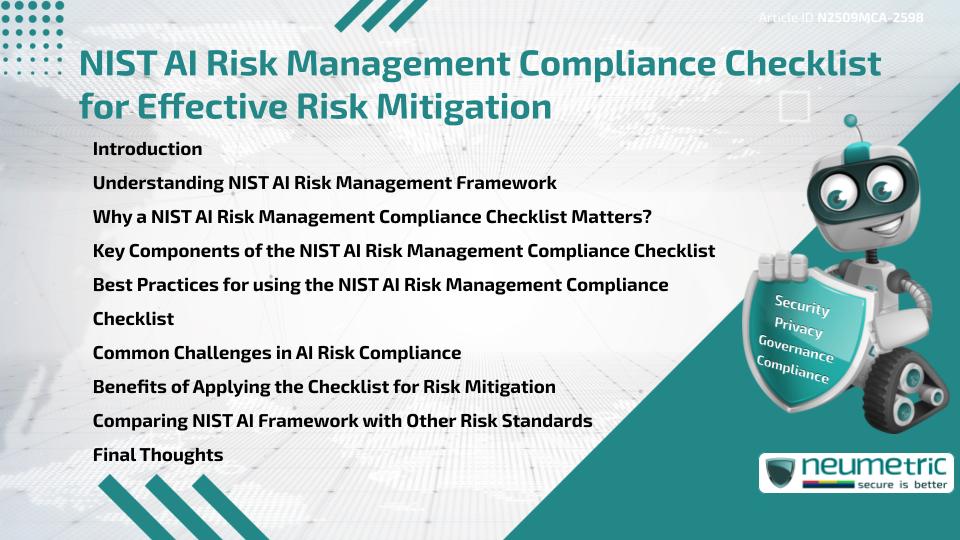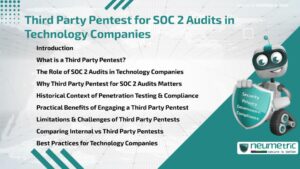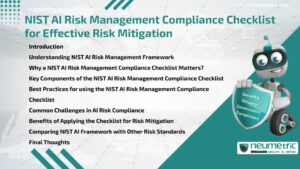Table of Contents
ToggleIntroduction
Artificial Intelligence [AI] brings transformative opportunities but also introduces Risks related to fairness, Privacy, accountability & security. To help organisations address these challenges, the National Institute of Standards & Technology [NIST] developed the AI Risk Management Framework [AI RMF]. A practical way to apply this Framework is through the NIST AI Risk Management compliance checklist. This article explains its importance, key components, Best Practices, challenges & benefits for effective Risk Mitigation.
Understanding NIST AI Risk Management Framework
The NIST AI RMF provides structured guidance for managing Risks associated with AI Systems. It promotes trustworthy AI by focusing on reliability, safety, transparency & fairness. Unlike technical-only approaches, the Framework integrates Governance, Risk evaluation & human oversight. It is designed to be flexible, applicable across industries & supportive of innovation while safeguarding against harm.
Why a NIST AI Risk Management Compliance Checklist Matters?
AI Systems are increasingly used in decision-making that affects individuals & organisations. Without proper safeguards, Risks such as bias, lack of transparency & data misuse can arise. The NIST AI Risk Management compliance checklist ensures that institutions systematically apply the Framework. It provides a step-by-step guide to embedding accountability, aligning with regulatory requirements & maintaining trust in AI applications.
Key Components of the NIST AI Risk Management Compliance Checklist
A comprehensive checklist typically covers:
- Governance & Oversight: Assign responsibility for AI Risk Management at senior levels.
- Risk Identification: Evaluate potential Risks such as bias, discrimination or misuse.
- Data Management: Ensure data quality, Privacy & compliance with regulations.
- Model Transparency: Document how AI Models work & make decisions.
- Security & Resilience: Protect systems from adversarial attacks & ensure continuity.
- Accountability Measures: Define clear processes for responsibility & redress.
- Monitoring & Review: Establish regular Audits to identify new Risks & improve safeguards.
Best Practices for using the NIST AI Risk Management Compliance Checklist
Organisations can enhance effectiveness by:
- Customising the Checklist: Adapt it to fit industry-specific Risks.
- Engaging Stakeholders: Involve legal, technical & ethical experts.
- Embedding Early: Apply the checklist at the design stage of AI Systems.
- Continuous Updates: Revise the checklist as technologies & regulations evolve.
- Training Teams: Ensure staff understand both technical & ethical considerations.
Common Challenges in AI Risk Compliance
Organisations often struggle with limited resources, lack of expertise in AI ethics & rapidly changing regulations. Ensuring vendor compliance when Third Party AI tools are used can also be difficult. Additionally, balancing innovation with stringent Compliance Requirements may slow adoption if not managed effectively.
Benefits of Applying the Checklist for Risk Mitigation
Using the NIST AI Risk Management compliance checklist offers multiple benefits. It helps reduce legal & reputational Risks, fosters public trust, improves system transparency & ensures regulatory alignment. Moreover, it promotes collaboration between technical & non-technical teams, creating a holistic approach to responsible AI adoption.
Comparing NIST AI Framework with Other Risk Standards
While standards like [ISO 42001] and [OECD AI Principles] also address AI Governance, the NIST AI RMF is more detailed in Risk Management & practical applications. The checklist approach makes it easier for organisations to operationalise AI Risk Management compared to high-level principles offered by other standards.
Final Thoughts
The NIST AI Risk Management compliance checklist is a powerful tool for mitigating AI-related Risks. By following its structured approach, organisations can strengthen accountability, ensure compliance & build trustworthy AI Systems that align with both Ethical Standards & regulatory expectations.
Takeaways
- The NIST AI Risk Management compliance checklist operationalises AI RMF principles.
- It covers Governance, Risk identification, Data Management & accountability.
- Benefits include stronger compliance, transparency & trust in AI Systems.
FAQ
What is the NIST AI Risk Management Framework?
It is a structured set of guidelines from NIST to manage Risks associated with AI Systems.
How does the checklist support AI Risk Management?
It provides practical steps for applying AI RMF principles, ensuring consistency & accountability.
Who should use the NIST AI Risk Management compliance checklist?
Any organisation developing, deploying or using AI Systems can apply it to manage Risks effectively.
Is the checklist mandatory?
No, it is voluntary but widely recommended for organisations aiming to demonstrate responsible AI Practices.
How often should the checklist be reviewed?
Organisations should review it regularly, particularly when new AI Systems are introduced or regulations change.
How does NIST AI RMF compare with ISO 42001?
NIST focuses on practical Risk Management, while ISO 42001 provides broader Governance requirements.
Can Small Businesses apply the checklist effectively?
Yes, smaller organisations can scale the checklist to their resources & Risks, focusing on core elements.
Need help for Security, Privacy, Governance & VAPT?
Neumetric provides organisations the necessary help to achieve their Cybersecurity, Compliance, Governance, Privacy, Certifications & Pentesting needs.
Organisations & Businesses, specifically those which provide SaaS & AI Solutions in the Fintech, BFSI & other regulated sectors, usually need a Cybersecurity Partner for meeting & maintaining the ongoing Security & Privacy needs & requirements of their Enterprise Clients & Privacy conscious Customers.
SOC 2, ISO 27001, ISO 42001, NIST, HIPAA, HECVAT, EU GDPR are some of the Frameworks that are served by Fusion – a SaaS, multimodular, multitenant, centralised, automated, Cybersecurity & Compliance Management system.
Neumetric also provides Expert Services for technical security which covers VAPT for Web Applications, APIs, iOS & Android Mobile Apps, Security Testing for AWS & other Cloud Environments & Cloud Infrastructure & other similar scopes.
Reach out to us by Email or filling out the Contact Form…





